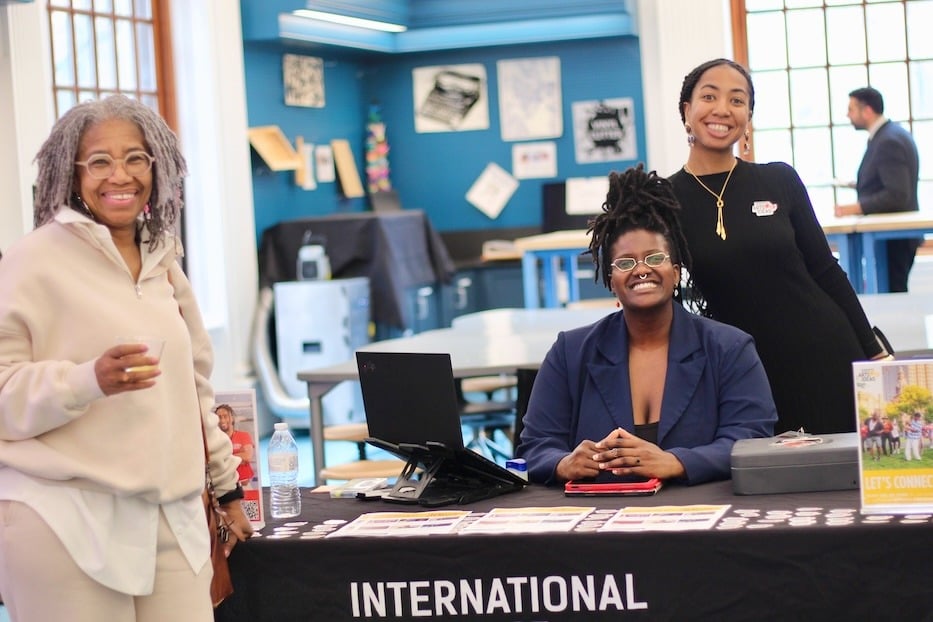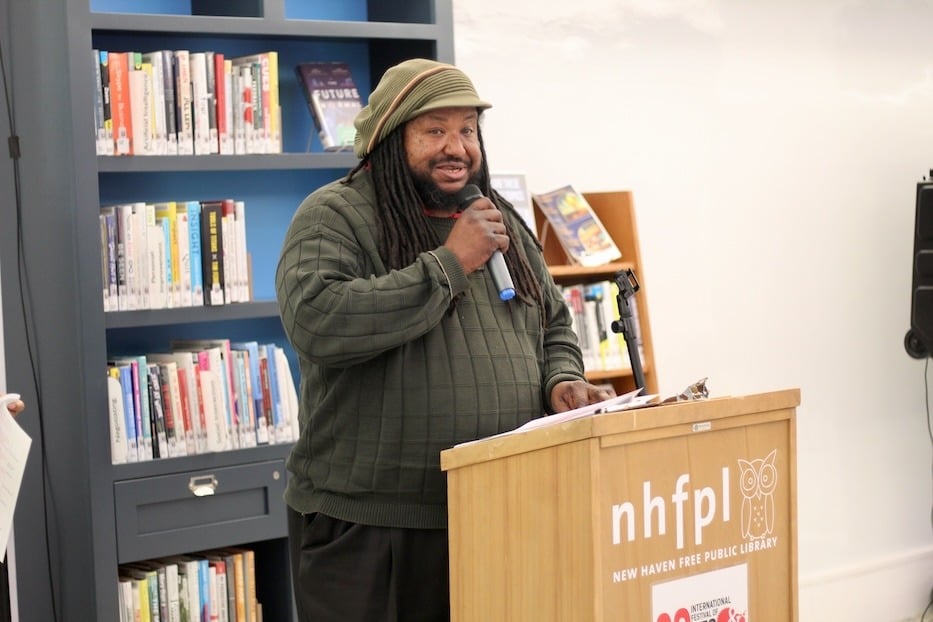
Culture & Community | International Festival of Arts & Ideas | Arts & Culture | New Haven Free Public Library

Interim Director Kevin Ewing. Lucy Gellman Photos.
A jazz quartet that may leave the house speechless as a saxophone replaces any need for words. A mobile circus troupe where a trampoline becomes a storytelling device, and a food truck a portal to another world. A “City of Floating Sounds,” where strains of symphonic music lead to the New Haven Green. A Latin Grammy winner with powerhouse vocals and a deep dive into book bans that feels eerily apropos.
All of those are coming to a scaled-down, tightly curated International Festival of Arts & Ideas this spring and summer, beginning with the all-city “Big Read” and Sister Cities Film Festival this month. A celebration of New Haven’s vibrant arts scene—and of its diversity—this year’s events bring together thinkers, writers, culture-bearers and performers across the arts, from water protector Autumn Peltier to a multi-media ensemble launched in a Pittsburgh junkyard.
It marks the Festival’s 30th anniversary year, and the first since Executive Director Shelley Quiala stepped down last August.
“There have been a lot of changes. But the Festival keeps going. We keep going. And we've been going for 30 years,” said Interim Director Kevin Ewing in a short series of remarks last Thursday, during an intimate launch at the New Haven Free Public Library. “Our theater is resistance. Our dancing is resistance. Our laughing is resistance. Our very existence is resistance.”

IfeMichelle Gardin, Audience Services Manager Quiana Stanley, and Associate Director of Education & Community Impact Shamain (Sha) McAllister.
This year, that begins this month with the Big Read, a community-wide event focused on Ray Bradbury’s Fahrenheit 451 and the danger that happens when the right to read is challenged. Following a kickoff at the Wilson Branch Library earlier this month, the Big Read comprises book clubs in New Haven and West Haven Library, a writing and drawing workshop, discussions, and youth Stay & Play and storytime activities that can help parents talk about censorship and book bans with their kids.
For the first time in recent history, it is taking place without funding from the National Endowment for the Arts (NEA), which in years past has granted the Festival $20,000 specifically for the event and affiliated programming. This year, partners on the event include the New Haven Free Public Library (NHFPL) and West Haven Public Library; CT Humanities also awarded the Festival a $4,999 quick grant specifically for the program. This month, the NHFPL is distributing 500 free copies of the book over its five branches.
It’s just the beginning of over two months of arts programming in the city, from circus to climate activism. Alongside the Big Read, the Festival and NHFPL are also hosting a film festival celebrating and exploring New Haven’s eight sister cities, from Afula-Gilboa, Israel to Huế, Vietnam. Scheduled between April 7 and May 29, the films turn a broad lens on communities around the world, with films that bring together Israeli and Palestinian women, lost dispatches from the Vietnam War, the Amistad Revolt and more.
New Haven’s sister cities include Amalfi, Italy; Afula-Gilboa, Israel; Avignon, France; Freetown, Sierra Leone; Huế, Vietnam; Léon, Nicaragua; Changsha, China; and Tetlanohcan, Mexico. The festival’s lineup of films also features a screening of Where Then Shall We Go?, which premiered earlier this year on Connecticut Public, and Titus Kaphar’s Exhibiting Forgiveness.

Serena Scapagnini, artist in residence at the Yale Quantum Institute, and artist and curator Martha Lewis.
That programming brings New Haveners solidly into May, which will see six neighborhood festivals, including a return to Fair Haven Day and new celebration in Whalley/Edgewood/Beaver Hills in the parking lot of Bethel AME Church on Goffe Street. On May 9 and 10, the Festival plans to partner with Westville Village Renaissance Alliance (WVRA) and the Yale Schwarzman Center to present Cirque Kikasse on Westville’s Central Patio and the New Haven Green.
For the first time this year, it’s a way for festival programming to intersect with both Westville Artwalk and Wake Up the Green, an annual day of service and spring festival from the Proprietors of the New Haven Green and a number of community partners.
It’s one of multiple New Haven partnerships that have made the festival feel, in recent years, more authentically embedded in the city’s neighborhoods and communities. In late May, the Festival is once again part of celebrating Freddy Fixer Weekend, with a Dixwell neighborhood celebration sandwiched between the Freddy Fixer Gala that Friday and the pomp and spectacle of parade day itself on June 1.
The weekend before that, festival staff and community members will also celebrate Newhallville and West Hills/West Rock. Those festivals have, in recent years, grown largely thanks to Festival employee Sha McAllister, associate director of education and community impact.
“Please come!” said McAllister to smiles and contented murmurs Thursday. She added that the Festival’s Fellows, a group of New Haven high school students, are already deep into their annual program, which includes a graduation ceremony in late June.

Clifford Schloss and Sha McAllister.
As May flows into June—in New Haven, the Freddy has long signaled an early start of summer—the Festival heads into the bulk of its programming, which will take place from June 14 to 28 in downtown and on the New Haven Green. Amidst walking and bike tours that have become a festival mainstay, events begin June 13 with Family Business: (A)Pizza Play, a production from A Broken Umbrella Theatre that has been in process for over a year (an earlier version premiered during the festival last summer).
In that week alone, there is a small marathon of both ticketed and free events, from live circus to a return of “Stir the Style,” a now-beloved storytelling event with music and poetry at C.I.T.A. Park (click here for a full schedule). Then June 19 through 22, the Festival once again presents a days-long celebration of Juneteenth, a collaboration with the Official Juneteenth Coalition of Greater New Haven that includes a restaurant week, multiple outdoor concerts, hip-hop conference and events during the day and into the evening on the Green.
The final week of the Festival, meanwhile, may be its most packed and propulsive. In addition to Huang Ruo’s “City of Floating Sounds,” a performance that blends symphonic music and smartphone technology (in this case, with Maestro Perry So and members of the New Haven Symphony Orchestra), the week includes jazz, mariachi, Cuban soul, poetry and comedy, with performers such as saxophonist Joshua Redman, New Haven's beloved Seny Tatchol Camara, and the Montreal-based jazz folk band Christine Tassan et les Imposteures.

Risë Nelson and Annie Lin, both board members at the festival. Nelson, an assistant dean who for years led the African American Cultural House at Yale, is the Director of Diversity, Equity, Inclusion, and Accessibility for the Yale Library. Lin is the director of community engagement and strategies at the Yale School of Art.
“Are you excited yet!?” Ewing said to an enthusiastic chorus of “Yes!” from the audience. He added that the festivities include the annual Visionary Leadership Award, the ceremony for which will take place June 11. This year, the award is going to Monique Martin, founder of Minty Fresh Circus. The group performs June 14 and 15. Two weeks later, the Festival concludes with the annual New Haven Caribbean Heritage Festival.
In addition, this year’s Festival includes “Ideas” talks with partners like the Yale Quantum Institute and keynote speakers Martyna Majok, a former Festival staffer who is working on a dramatized version of Fahrenheit 451, chef Jacques Pépin, and Anishinaabe-kwe and Wikwemikong First Nations activist and water protector Autumn Peltier.
The launch announcement (which includes a live calendar of events on the website) comes as the festival pulls back significantly on its spending, from the number of performances to the artists it has been able to invite to New Haven. In the past two years, the organization has operated with a budget between $2 and $4 million (last year, the Festival clocked in at just over $4 million), with historic sold-out crowds at big ticket events like jazz vocalist Samara Joy at College Street Music Hall.
Now, Ewing said, it’s necessary to cut back—while holding fast to the joy and magic of the arts—as a matter of survival. Since he stepped into the interim position last year, he’s noticed that major funders aren’t giving in the same way they did a year ago. Some of them seem more cautious in the current political climate, he said. Others simply don’t have the same discretionary funds that they did a year or two ago. Expected grants, like the NEA’s $20,000, didn’t come through.
“What that meant was we sought programming that was a little different,” Ewing said. Unable to pay $40,000 to $50,000 for a headliner, Ewing caught performers “who were on their way up,” but just as talented as many of the big name artists who have graced the festival in the past.
That's palpable in everything from programming to the internal discussions he's having with staff, he added. When it was time to choose a festival theme this year, he originally suggested "Harmony," because it captured the festival's spirit of coalescence and cultural euphony. But around him, the world didn't feel very harmonious: there were mounting attacks on the kind of diversity that is core to the festival's existence. So he went back to the drawing board.
Then he suggested a "Pearl Anniversary," because the festival is celebrating 30 years in New Haven. Over three decades, the Festival has become "a beautiful pearl in the City of New Haven," he said—magnificent and luminous in its ability to bring people together around the arts. But the idea of a pearl "felt arrogant," and he found himself again unsure that it was the right fit for the festival.
"I started thinking about, 'Okay, so, what is a pearl?'" he said. "How is a pearl made? See, a pearl is created when a mollusk, an oyster or a clam or some shelled water creature, gets an irritation. Something gets between its shell and it starts to bug it. And so what does the clam do? What does the oyster do? Its resources start coming together, and getting around the source of that irritation ... and over a period of six months to a year or however long it takes, that irritation becomes a precious jewel."
That, he could get on board with. The Festival wasn't the pearl, he explained to a small audience Thursday. It wasn't the grain or sand or the single irritant, either. It was the mollusk, bringing its resources together to produce something rare and precious and splendid.
"We bring together our deep entertainment, our cultures from all around the world, we bring together these deep conversations, these conversations about ideas and thoughts that most people don't want to be said out in public," he said. "We bring together these books and thoughts and events that speak around things that are currently bad words ... we come together and create resistance. Resistance to the issues that are causing this irritation."

